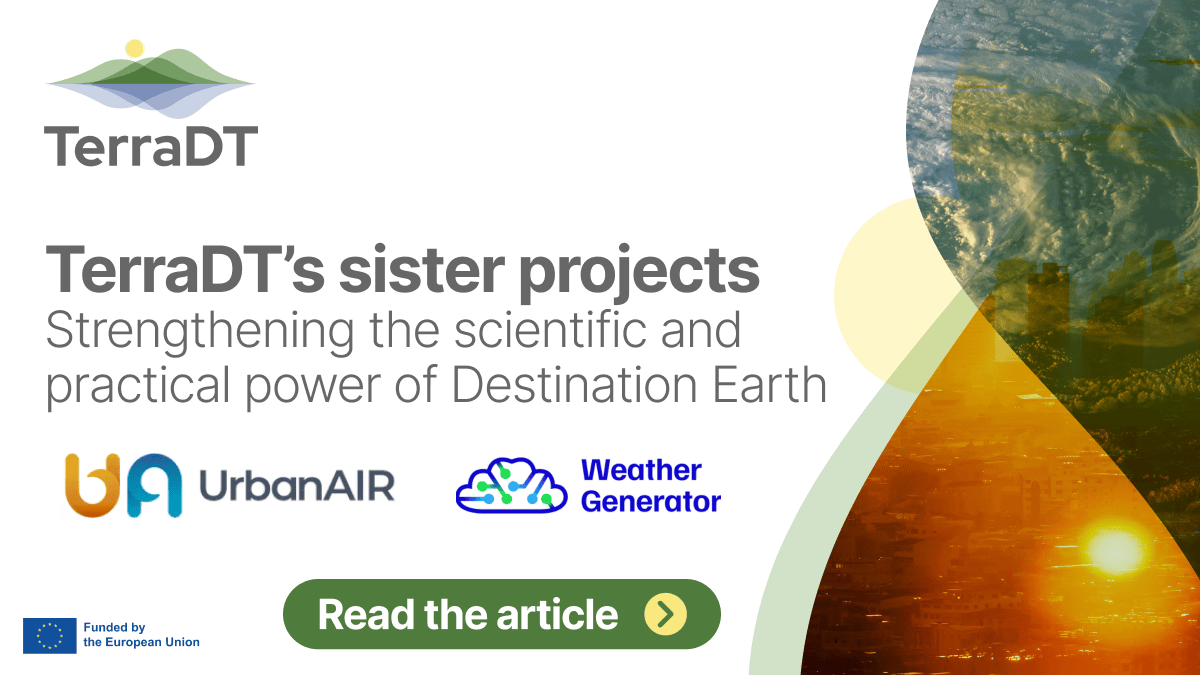TerraDT is one of three projects launched in January and February 2025 under Horizon Europe to strengthen Destination Earth (DestinE), Europe’s initiative to build a high-precision, interactive digital twin of the Earth. Digital twins are computational models of real-world phenomena that can be used to simulate the past, model the present, and predict the future. Together with TerraDT and UrbanAIR, we expand the DestinE ecosystem by addressing different but complementary aspects of the Earth system.
What do the projects focus on?
TerraDT aims to improve how the DestinE Climate Digital Twin represents land, ice, and aerosols – areas where kilometer-scale climate models have faced limitations. The project develops new components for land ice, sea ice, and land surface dynamics, while also creating impact models for forests, urban temperature extremes, carbon sequestration, and coastal infrastructure. Utilizing modular and interoperable software infrastructure and multi-decadal simulations on Europe’s most powerful supercomputers, TerraDT provides more reliable and detailed datasets that can also serve as valuable inputs for WeatherGenerator. It is coordinated by CSC – IT Center for Science in Finland.
UrbanAIR focuses on helping cities adapt to climate change by addressing challenges in air quality, urban heat, and green infrastructure planning. Working with five European cities – Barcelona and Antwerp as “action cities,” and Paris, Rotterdam, and Bristol as “learning cities” – the project links large-scale climate models with detailed street-level simulations and behavioural models that capture how people respond to changing environments. By bridging global climate information with local policy needs, UrbanAIR supports data-driven decisions for healthier, more resilient cities. The project is coordinated by Delft University of Technology.
WeatherGenerator brings advanced machine learning into the heart of DestinE. Instead of building a task-specific model, WeatherGenerator is developing a large-scale, general-purpose foundation model for weather and climate, trained on massive and diverse datasets – from observations to reanalysis and simulations. This allows us to generate a wide variety of outputs: scenario-based weather fields, probabilistic forecasts, or impact-relevant indicators such as energy demand.
Collaboration
Together, the three Sister Projects are building complementary solutions which strengthen the scientific and practical power of Destination Earth. High-resolution models from TerraDT help improve WeatherGenerator's training data, while UrbanAIR provides real-world use cases for testing and applying outputs in urban environments and support TerraDT's urban impact modelling efforts. In return, WeatherGenerator scales insights from global to local, helping both TerraDT and UrbanAir, as well as the broader community, turn complex digital twin data into actionable knowledge.
In July 2025, the three projects came together for their first joint webinar, highlighting how their complementary approaches reinforce the DestinE vision.
A post-event summary is now available – read it to explore key insights and discover how the Sister Projects are working together.
